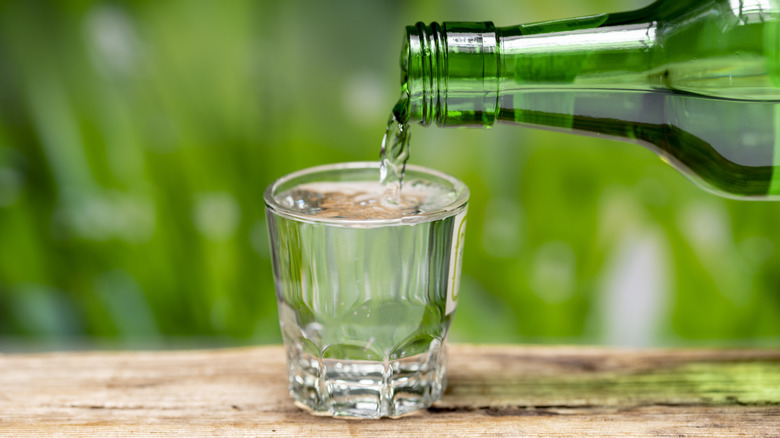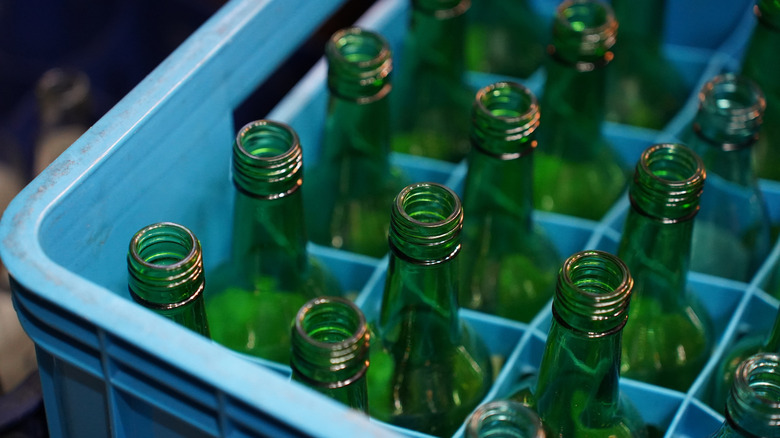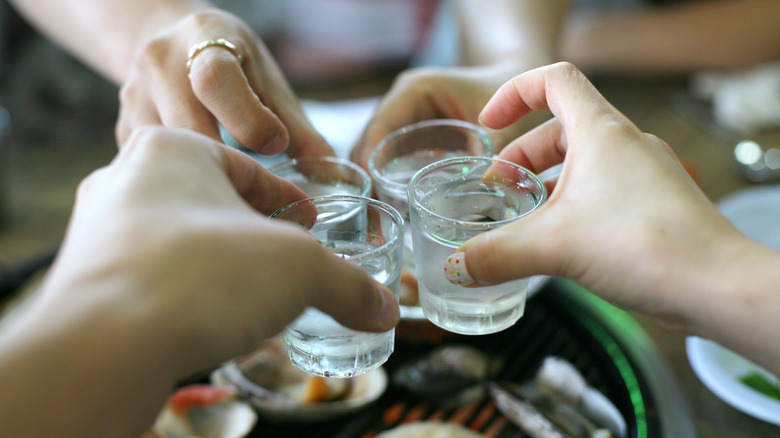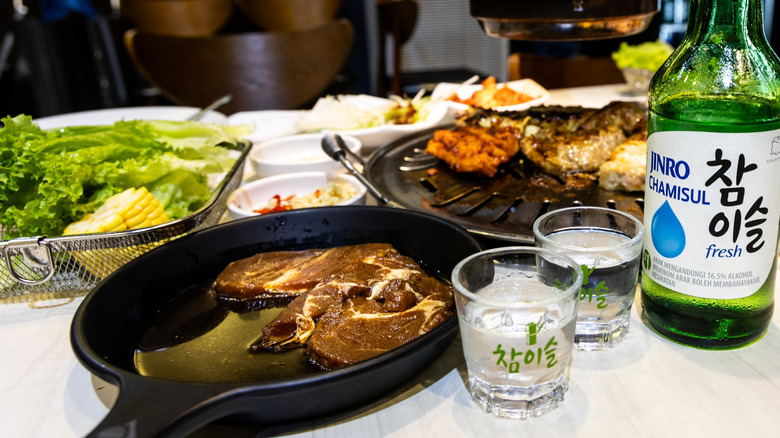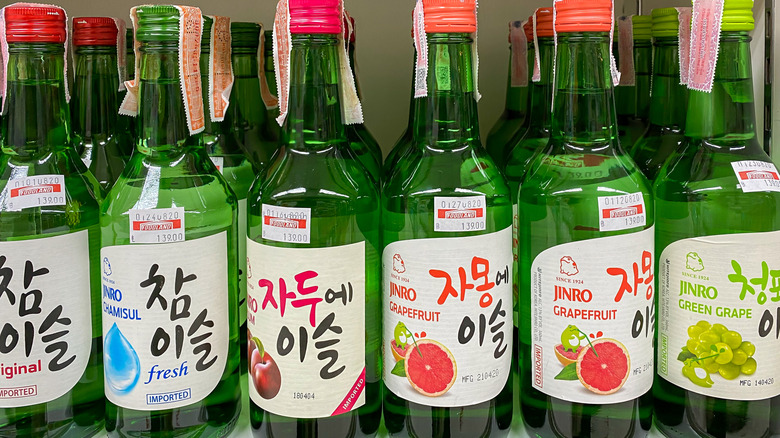You've Been Drinking Soju Wrong This Entire Time
In the world of Korean spirits, soju stands out as a versatile drink that has surged in global popularity. Millions have embraced it, but without fully understanding the traditions and nuances that make it such a unique drink. Julia Mellor, the founder of The Sool Company, has dedicated her career to helping people understand how to properly enjoy soju and other Korean spirits, promoting traditional Korean drinking practices through her company.
Mashed spoke to Mellor about the mistakes people make while drinking soju, and she emphasized how soju is not just alcohol but a part of Korean culture, meant to be savored in the right context. Many associate it with being a simple, mass-produced spirit, but its historical and cultural significance runs much deeper. Soju is synonymous with social gatherings, and the way it's enjoyed reflects camaraderie, respect, and tradition. Whether by drinking too much, not drinking with friends, pairing it with inharmonious foods, or only drinking the flavored stuff, you may have been drinking soju wrong this whole time.
Drinking too much
It's safe to say that soju wouldn't have reached worldwide popularity if it weren't for its smoothness and agreeable taste. Combined with the social custom of drinking in shots, it's all too easy for people to accidentally drink too much. "The biggest mistake is to forget that it's a distilled spirit and the ABV% can sneak up on you," Julia Mellor explains. Soju can range from around 16% alcohol by volume, more typical for fruit flavors, all the way up to 40%. Consumers should always check the bottle before drinking to know what they're getting into.
In the Korean language, the phrase "Anjeong Baengi Sool" (which translates to "legless drinks") encapsulates this phenomenon. Mellor explains, "[It's] the idea of sitting and drinking and not noticing how strong it is until you stand up and feel your legs wobble." Soju may not taste very strong and might seem like a light drink, but this myth about soju should be debunked, especially for first-time drinkers. In fact, 40% ABV is a more traditional form of the drink, although mass-produced soju has reduced alcohol content over the decades for ease of drinking and to attract more customers.
Not drinking with friends
In addition to not pacing yourself, another big mistake when drinking soju is having it alone. The drink is traditionally shared in a group setting, as part of social bonding or celebration. "Soju is most commonly enjoyed neat in shot glasses, shared together with family and friends over food," Julia Mellor told us. In Korea, alcoholic beverages like soju stimulate lively conversations and break the ice. Even amongst coworkers, sharing a bottle is not uncommon. Company dinners, known as hoeshik, may happen a couple of times a month outside of work, giving colleagues a chance to unwind and build relationships. A 2018 study found that going out with colleagues was the second most common drinking scenario in Korea, just after going out with friends.
The ties between drinking alcohol and building community run deep in Korean culture, and embracing this practice globally allows everyone to experience soju as it was meant to be enjoyed. Drinking games are also a part of many social gatherings in Korea, adding a playful, interactive element to the evening. A great example is the drinking game that inspired K-pop star Rosé and Bruno Mars' song "APT", called the Apartment Game. Games like these are always easy to play at a table, involving no game gadgets or equipment, just people and laughter. These social rituals add a layer of meaning that elevates the drink beyond its alcohol content, so invite a few friends over the next time you have a bottle of soju.
Not drinking with food (or the right foods)
Drinking soju communally with friends is naturally complemented by a meal or a hearty snack and forgoing the food altogether would be a mistake. The right food can significantly enhance both the drink and dining experience. According to Julia Mellor, "Table strength soju is often slightly sweet, clean, and soft, which pairs well with grilled meats such as Korean barbecue and also rich and spicy soups." This could include the quintessential KBBQ cut samgyeopsal, aka pork belly, or the burbling stew, kimchi jjigae.
Although the flavors of Korean food may be harmonious with soju, you can find good pairings across many cuisines. Meaty, protein-rich foods like steak and brisket, greasy meals like chicken wings and hamburgers, or spicy curries and hot pot all warrant a bottle of soju at the table. Moreover, stronger soju can pair well with an elevated snack. "Spirit strength soju is [ideally] sipped with on the rocks with cured meats and cheese, or incorporated into cocktails." This combination of soju and charcuterie is a refined experience many would appreciate.
Only drinking flavored soju
While shelves abroad may not always carry traditional soju, they are more often stocked with globally popular flavored soju varieties. Flavored soju is a relatively recent invention, with the first varieties emerging in 2015. Given their fruity flavor profiles, it's no surprise that this type of soju is driving its popularity outside of Korea, but you're missing out if you're only drinking this style.
"These more 'cocktail' or 'RTD' style soju are not nearly as popular in Korea, because of the fact that soju is enjoyed with food," Julia Mellor says. This is because traditional soju is clean tasting and complements Korean food's savory and often spicy flavors without overpowering them. In contrast, RTD (ready-to-drink) beverages are often carbonated and sweet, making them better suited to have on their own.
This reflects differences in drinking culture as well; in Korea, the emphasis is placed on pairing soju with food, while elsewhere the emphasis is placed on the drink itself. A sweet and fruity drink is more approachable, perfect for creating fun cocktails, and appeals to a wide range of tastes at a party. Furthermore, fruit-flavored soju typically has a lower alcohol content, making it even easier for consumers to enjoy. For a more authentic experience, opt for a flavorless soju alongside a meal with friends to truly appreciate its traditional role in Korean culture. And don't forget to pace yourself!
